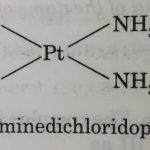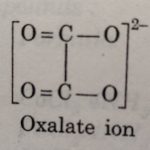Bonding In Coordination Compounds Valence Bond Theory For Bonding In Coordination Compounds The Main Assumptions of this Theory are listed below : (1) The central metal ion in the complex makes available a number of empty orbitals for the formation of coordination bonds with suitable ligands. The number of empty orbitals made available for this purpose is equal to … [Read more...] about Valence Bond Theory For Bonding In Coordination Compounds
Coordination Compounds
Isomerism in Coordination Compounds
Isomerism Two or more compounds having the same molecular formula but different arrangement of atoms are called isomers and the phenomenon is called isomerism. Because of different arrangement of atoms, isomers differ in one or more physical or chemical properties. Isomers can be broadly classified into two major categories : (A) Structural isomers (B) … [Read more...] about Isomerism in Coordination Compounds
IUPAC Nomenclature of Coordination Compounds
IUPAC Nomenclature of Coordination Compounds Rules for Writing Formula The formula of a compound is a shorthand method used to provide basic information about the constitution of a compound in a concise and convenient manner. (1) The formula of the cation whether simple or complex is written first followed by that of the anion. (2) The coordination entity is written … [Read more...] about IUPAC Nomenclature of Coordination Compounds
Terms used in Coordination compounds
Terms used in Coordination compounds Coordination Entity or Complex lon A coordination entity constitutes a central metal atom or ion bonded to a fixed number of oppositely charged ions or neutral molecules. For example : [CoCl3(NH3)3] is a coordination entity, in which the cobalt (+3) ion is surrounded by three ammonia molecules and three negatively charged chloride … [Read more...] about Terms used in Coordination compounds
Werner’s Coordination Theory
Werner's Coordination Theory Alfred Werner a Swiss chemist, in 1892 prepared a large number of coordination compounds and studied their physical, chemical and isomeric behaviour by simple experimental techniques. He isolated cobalt compounds from the reaction of cobalt chloride and ammonia. The earlier studies of cobalt complexes were precipitation reactions, conductance … [Read more...] about Werner’s Coordination Theory
![[Co(NH3)6]3+](https://classnotes.org.in/wp-content/uploads/CoNH363-150x150.jpeg)
![[Pt(Cl2(NH3)2]](https://classnotes.org.in/wp-content/uploads/PtCl2NH32-150x150.jpeg)


![structure of [Co(NH3)6]Cl3](https://classnotes.org.in/wp-content/uploads/CoNH36Cl3--150x150.jpg)